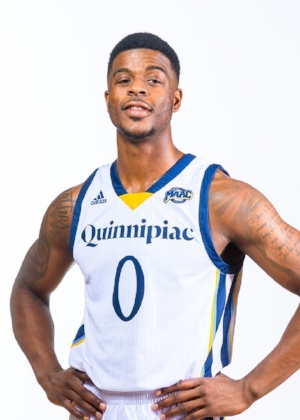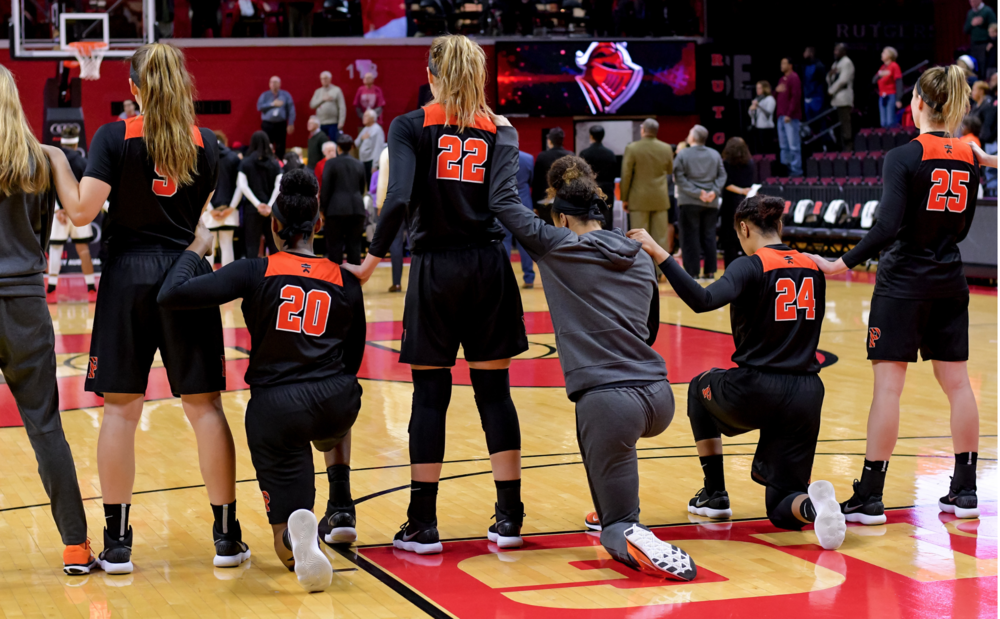By Aaron Robinson

Perspective: Quinnipiac’s Aaron Robinson offers his personal thoughts as a Bobcat athlete.
On the afternoon of Dec. 9, 2017, the Quinnipiac University women’s basketball team lined up across the free throw line of its home arena standing at attention for the national anthem, holding hands as the players always do.
Directly across from the home team, the Princeton women’s basketball team looked quite a bit different.
As the anthem played, the 509 fans that were in attendance stood at attention, hats removed, eyes locked on the flag. No one seemed to notice that a few members of the Princeton women’s team were not standing. Instead, these players knelt in protest.
“I believe that police brutality and excessive violence is an issue in our country and that the use of force and police power disproportionately affects people of color,” Sydney Jordan, a senior on that Princeton Tigers, team said.
That, she said, is why she knelt.

Jordan and her teammates followed the lead of former National Football League quarterback, Colin Kaepernick, who first took a knee during the anthem before a preseason game in August 2016 — a summer that witnessed a rash of police brutality against African American men.
Police officers shot and killed unarmed black men, such as Alton Sterling in Baton Rouge and Philando Castile outside of Minneapolis. Baltimore police found Freddie Gray dead in the back of a police van after he sustained injuries in custody, and an officer gunned down Terence Crutcher in the middle of a Tulsa street. None of the officers were found guilty.
These are just a few of the 855 African Americans who have been killed by the police since 2015, according to the Washington Post’s police shooting database. Of these 855 people, 90 were unarmed and another 27 were killed while possessing a toy gun.
The anger and frustration in the black community spilled into the playing fields and arenas of American sports.
“I am not going to stand up to show pride in a flag for a country that oppresses black people and people of color,” Kaepernick told NFL.com. “To me, this is bigger than football and it would be selfish on my part to look the other way. There are bodies in the street and people getting paid leave and getting away with murder.”
When Kaepernick took a knee, many fans and observers interpreted his action as a show of disrespect to the the flag and military.
On the other side of the issue, many maintained the action was a display of his First Amendment right to freedom of speech.
“I often think about the statement that Kaepernick and others in the NFL made and how, when limited to a single sport at a single competition level, it might appear as if other people don’t care,” Jordan said. “Thus, it was important to me to send the message that it’s not just a few successful football players who feel strongly about police brutality.”
Jordan and her teammates at Princeton, an Ivy League institution, were among few college athletes to join in what commonly became dubbed a “protest.”
Quinnipiac women’s basketball coach Tricia Fabbri stood on the sideline that afternoon when Tigers players knelt.
“I think how it’s been dealt with at the highest level just has a trickle-down effect,” Fabbri said. “You would understand young kids being nervous about what a university would think about them taking a stance. I think there are examples going on in real life that would give them real pause.”
Fabbri noted that Kaepernick, two seasons after his initial kneel, is still out of a job in the NFL. Eric Reid, who was Kaepernick’s teammate in San Francisco. only recently got signed again after a two-year hiatus from the NFL.
NFL owners came up with a policy that forces players to stand and “show respect” for the flag. And, President Donald Trump has made the athletes’ displays a rally cry, calling players who protest “sons of bitches” and going so far as to suggest they don’t belong in the U.S.
“You have to stand proudly for the National Anthem. You shouldn’t be playing, you shouldn’t be there. Maybe they shouldn’t be in the country…the NFL owners did the right thing” -President @realDonaldTrump pic.twitter.com/bt36t4EX5u
— FOX & friends (@foxandfriends) May 24, 2018
In 2018, ESPN the Magazine senior writer Howard Bryant published “The Heritage: Black Athletes, A Divided America, and the Politics of Patriotism.” The book details a history of athlete protest dating back to the 1940s, as well as police brutality against people of color reaching back even farther.
“Look at the people who speak out, they get killed,” Bryant said metaphorically. “What happened to Tommie Smith and John Carlos? They got destroyed. What happened to Muhammad Ali? He got destroyed? What happened to Colin Kaepernick? He got destroyed.”
The message, Bryant suggested, to college athletes is clear — stand or be destroyed.
Still, many see the complexity of the simple act of kneeling.
Quinnipiac’s chief diversity officer Don Sawyer, a former member of the military, said, “When we think about the people who are defending our freedom and fighting for the Constitution, they are fighting for our right to be able to protest in this nation.”
It is this culture that has been created by America and by a lot of these sports leagues that causes a lot of athletes, African American ones in particular, to exercise extreme caution when speaking out on social issues, and the pressures are magnified when examined from a college athlete’s perspective.
“I think in the college game, guys feel like they can be easily replaced and they don’t have the security to do something that could jeopardize their position,” said Taylor McHugh, a senior guard on the Bryant University men’s basketball team in Smithfield, Rhode Island. “A lot of guys fear the consequence and the backlash a little more than pros. The consequences are more severe.”
This idea of fear is one that comes up often for college athletes thinking of standing up for social justice. Ironically, most schools do not have policies that prohibit athletes from speaking out.
“We had conversations as an athletic department saying, ‘If it was to happen, what would be our reaction?; And the reaction would not be a retaliatory one,” Quinnipiac athletic director Greg Amodio said. “We are not interested in stifling anybody’s ability to deliver a message.”
Amodio said he actually hasn’t heard of policies elsewhere, either.
“When a lot of the protesting was going on, there was a lot of conversations amongst ADs saying, ‘What would you do? What would you do?’ and nothing like that ever came up,” he said.
Still, no athlete at Quinnipiac has put the lack of a policy to the test.
“I think the biggest reason is control. I think the player’s believe that they don’t have as much power as they have,” Bryant stated. “You walk in the door and they make it seem like they are doing you the biggest favor in the world. It is a matter of power, it is a matter of mindset.”
It seems fear has held the athletes in place.
“I’ve had friends who are college athletes who were thinking about protesting during the anthem, and it wasn’t necessarily, ‘If I protest, I’ll lose minutes,” said Trey Phills, a senior guard on the Yale men’s basketball team. “(Rather,) it was, ‘If I protest, this is going to detract from the team’s focus before a game,’ and the coach might have pushed against that or made them reconsider.”
College coaches and college administrators have an immeasurable impact on their players and the voice or lack thereof that their players have. Whether they explicitly state that protesting or participating in acts of activism are prohibited, athletes usually have a good understanding of what is and is not acceptable in the eyes of the university.
“I don’t recall someone specifically saying not to do it, but you could kind of feel the vibe that that might not be something that the university would like us to do,” McHugh said.
“In college, we’re young and we’re still trying to figure things out and often times you just want to take the path of least resistance just because you don’t know how that activism would affect your college career,” Phills said.
The fear of the unknown is a common theme among many college athletes. Not knowing how the coach would react, not knowing how the administration would react, not knowing how fans will react, or even potential employers.
College athletes often have worked their entire lives to put themselves in a position where they can have security in their life post college. The fear of losing all of that in the blink of an eye, as Kaepernick and many others did, is tangible.
Another factor is that NCAA student-athletes feel they are at the mercy of their respective universities when, in fact, the exact opposite may be the reality. Take, for instance, the collective action in 2015 of the University of Missouri’s football team, which threatened to boycott all football activities until the university president was fired or resigned. The football players — as well as many other students — were upset with the president Tim Wolfe’s handling of several racially charged incidents on campus. Two days after the threat, Wolfe stepped down.
“The common thread through Kaepernick, Kain Colter (who led a fight for the unionization of college football players in 2014) when he was at Northwestern, and (activist) Paul Robeson, is political education,” said Kevin Blackistone, a Washington Post sports columnist and professor of Journalism at the University of Maryland.
“They didn’t allow their colleges and universities to use them. They didn’t take study for granted — and that allowed them to understand not only their individual place in society, but the collective space people of color occupy.”
Jordan, who led the action for the Princeton women’s basketball team, got it.
“I think the comparative lack of activism at the college level can be, at least partially, traced to a feeling of uncertainty about our futures,” she said. “As college students, often without guaranteed employment, there is definitely a sense that we have not ‘made’ it yet. Consequently, I feel as if my future is very much dependent on the good will of others who want to see me do well.”